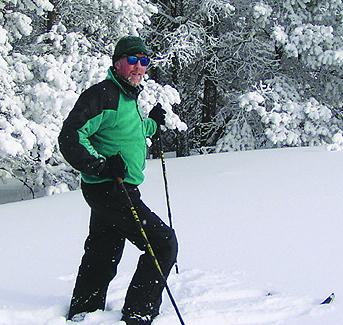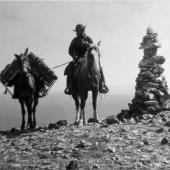Green Skiing in Montana's Mountains and Lodges
Montana is blessed with some of the finest skiing in the nation, offering dry, consistent snow and long winters. With fifteen downhill ski areas in Montana (and endless backcountry), there’s no lack of opportunity for all levels of skiing, from green runs to double black diamond steeps.
Green is a word with many connotations, from money to envy to environmentally sound business. How well does the ski industry perform when measured against “green” standards?
Despite some extremely snowy winters lately, scientists are generally in agreement that climate change will mean warmer temperatures, shorter winters, and ironically, more green (grass) and less of the white stuff. Fortunately, some Montana ski areas are joining in the effort to protect our longest, coldest season.

The National Ski Areas Association (NSAA, www.nsaa.org) promotes green business practices in the downhill ski industry through their Sustainable Slopes initiative and the “Keep Winter Cool” program. The Yellowstone Business Partnership mentors area businesses in conservation, community building and economic sustainable growth. See www.yellowstonebusiness.org. The Ski Area Citizen’s Coalition (SACC, www.skiareacitizens.com) grades ski areas on habitat and watershed protection, climate change response, and environmental practices and polices. Each year SACC assigns a letter grade to most major ski area in the US and some in Canada. Here’s the 2011 scorecard for Montana.
Here’s a rundown of what some ski resorts in Montana are doing...
Red Lodge Resort
Red Lodge Resort, near Red Lodge, MT, is a member of the YBP and is completing the UnCommon Sense program, which promotes waste-stream management, responsible purchasing and energy, water and transportation efficiency, as well as exploring business responses to climate change.
Bridger Bowl
Bridger is Montana’s only community-owned, nonprofit ski area, and is found in the Bridger Range north of Bozeman.
Bridger is actively participating in NSAA’s “Keep Winter Cool” program. They have convenient carpool parking lots at the ski area and at the Gallatin County Fair Grounds, and offer discounted lift tickets for carpools of three or more on certain holidays as well as a free employee shuttle bus. There’s also a free skier bus on weekends, and a kids’ bus on weekends and holidays.
Bridger recycles cardboard, glass, aluminum, and plastic—and all lubricant oils, lift grease, fryer fats, large steel, aluminum, wire, paper and magazines. They use 100% recycled paper for post cards, business cards, and brochures.
Bridger will be purchasing green tags for energy generated through zero emission heat exhaust captured from natural gas pump turbines in Basin Electric Cooperative’s North Dakota pipeline. The three lodges at Bridger emphasize natural lighting and all are equipped with energy-efficient light bulbs. The food service department will soon be using bamboo/ sugarcane based plate products in the cafeterias.
A 1976 double chair lift from Snowbird was used for the new Schlasman chairlift. Bridger completed YBP’s UnCommon Sense program in 2009.
Moonlight Basin
Moonlight Basin is located in Big Sky on the north slope of Lone Mountain. Over half of Moonlight Basin’s original 25,000 acres of private land are protected in conservation easements. Within the developed ski area, some wildlife corridors have been preserved.
Moonlight Basin offsets the energy required by ski lifts with renewable energy credits from NorthWestern Energy. Free public transportation between Bozeman and Moonlight Basin is offered by Skyline, eliminating thousands of car trips through environmentally-sensitive Gallatin Canyon and saving thousands of tons of CO2 emissions.
Recycling is emphasized at Moonlight, with most of the waste from their offices recycled, and convenient recycling bins available at the lodge for plastic, paper, cardboard and aluminum. Recycled building materials at Moonlight include the Headwaters lift and some of the terrain parks features, such as old propane tanks from a landfill.
Moonlight also is a graduate of YBP’s UnCommon Sense Program. Awards granted to Moonlight Basin include MSU Extension Service’s EcoStar Award and the NSAA’s Silver Eagle for Fish and Wildlife Habitat Protection and for Visual Impact.
Big Sky Resort
Lone Mountain provides the spectacular centerpiece of Big Sky, located adjacent to Moonlight Basin. This is Montana’s biggest ski area and is heavily developed. Combined with Moonlight, most of the perimeter of Lone Mountain is developed for downhill skiing.
Big Sky has boosted energy efficiency at Shoshone Condos and the Mountain Mall by replacing windows and doors. They have improved insulation and installed recycling bins in employee housing, and encouraged employees to use best practices with heating, lights and computer usage. Both the Summit Hotel and Shoshone have installed energy conservation systems called Entergize that automatically turn down thermostats and turn off lights when guests leave their room. The Village Center, Big Sky’s newest building installed an energy saving system called Tridium that can remotely manage energy use.
Big Sky was the first major resort to use cleaner 4 stroke snowmobiles. Big Sky offers all of its used grease from kitchen operations to be used for creation of biodiesel. Their vehicle maintenance shop is heated with used oil from their vehicles. Seven out of eight of Big Sky’s food operations offer reusable utensils. The last facility, the Lone Peak Café is due for remodel starting Spring 2012 to handle non-disposable operations. The resort has a recycling program for aluminum, plastic, paper and cardboard.
Big Sky has always been a financial supporter of the free Skyline bus service from Bozeman to Big Sky, and this year increased its contribution to add extra seats. Big Sky partners with Cool Earth, www.coolearth.org/boyneresorts to offset their carbon footprint by funding the purchase and protection of mature rainforest in Brazil. According to Cool Earth, every acre of rainforest protected keeps 260 tons of CO2 where it belongs—in the forest.
Big Sky also partnered with the Big Sky Institute to study the effects of the pine bark beetle on Whitebark Pine, which is in severe decline at Big Sky and throughout the Yellowstone region.
The SACC does not rate all ski resorts. A few of Montana’s smaller resorts deserve mention for their efforts.
Discovery Basin
Discovery Basin, located near Anaconda, is one of the most affordable ski areas in Montana ($38.00 per day), with some amazing back bowls. They use LEED-certified roofing shingles that improve insulation and are promoting recycling.
Discovery is most proud of their re-used ski lifts. Since 1984, Discovery has installed seven ski lifts, all purchased from other resorts such as Sun Valley, Deer Valley, Park City and Steamboat. It is not just the towers and chairs that are re-used, but also the cables, electric motors, gear boxes, motor rooms, and auxiliary diesel motors.
Showdown
Showdown ski area, in Neihart (near Great Falls), uses biodiesel for heaters in their maintenance shops. In the food service department they have phased out styrofoam in favor of paper products and offer real silverware instead of disposable plasticware. All light fixtures in the main lodge use energy efficient bulbs.
A bus to the ski hill is available on weekends, and there are two employee shuttle busses. All power for the resort comes from hydroelectric dams on the Missouri.
Great Divide Ski Area
This is a small ski area located in Marysville, near Helena. Great Divide recently installed a low-energy snowmaking system that uses gravity instead of fans to disperse man made snow, and are working on recycling and composting
So, if you are looking to help sustain Montana’s skiing lifestyle and reduce the impact of your winter fun, Montana’s skiing industry offers some solutions. We can all pitch in by encouraging better ways to run resorts, by car pooling to the hill or using public transport, by purchasing used gear, by recycling at the hill and a hundred other ways. Meanwhile enjoy winter while we’ve got it!
~ Phil Knight is an outspoken conservationist, backcountry explorer, musician, poet, and world traveler. Phil’s passion and lifelong avocation is protecting and exploring wild places and seeing and learning about wild creatures. In doing so, he has fallen out of several trees. Phil lives in Bozeman with Alaina, his wife of 15 years.












Leave a Comment Here